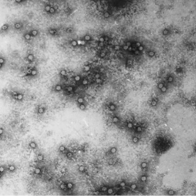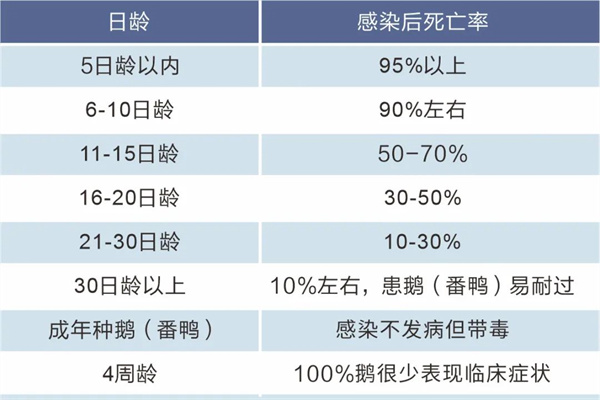Watson
Waterfowl Class
In recent years, as the amount and scale of waterfowl breeding in my country have continued to increase, there have been more and more types of poultry diseases. Today I will give you some popular science about a common disease in waterfowl: Gosling Plague

Gosling plague (GP) is a severe infectious disease in goslings caused by goose parvovirus. It mainly affects goslings aged 4 to 20 days, and the younger the age of onset, the higher the mortality rate. It is currently harmful to the goose industry. One of the major viral infectious diseases.
This virus only infects young waterfowl (geese, Muscovy ducks, and Cherry Valley ducks of various species) and does not infect other poultry. It only reproduces on waterfowl embryos.

The gosling plague virus belongs to the Parvoviridae family and is in the shape of a regular icosahedron (regular hexagon). It has two types of particles, hollow and solid. It has no capsule. When observed under an electron microscope, the virus in tissue cells is arranged in a lattice shape and has no hemagglutination. Some experiments suggest that the virus can agglutinate cattle sperm. This virus is mainly distributed in the intestines, liver and other tissues in the body. It has strong resistance and can withstand 56℃ for 1 hour. This virus has only one serotype and can proliferate in the allantoic cavity of goose and duck embryos, causing embryonic hemorrhage and death.

Gosling plague mainly affects goslings aged 4 to 20 days, with a mortality rate of 90%-100%, and the younger the age of onset, the higher the mortality rate. Sick chicks and latently infected adult geese are the main sources of infection. They can be infected through the digestive tract and respiratory tract, and have been proven to be vertically transmitted through eggs. There is no obvious seasonality in the occurrence of this disease. It is reported that young Muscovy ducks can also be infected with gosling plague virus and have similar clinical manifestations.

Clinical symptoms
During the incubation period of 3 to 5 days, the sick chicks showed obvious depression, anorexia, runny nose, severe diarrhea and neurological symptoms, passed watery stools containing bubbles, rapid dehydration, weight loss, and death. The course of the disease was 1 to 2 days. The main characteristics are retarded growth and development, shortened and deformed duck beaks, exposed and drooping tongues, lameness, paralysis, diarrhea, and easy breakage of wings and legs.
Pathological changes manifest as fibrinous membrane enteritis:
The small intestine, especially the duodenum, is enlarged, the serosa is dehydrated, caseated, and the mucosa is shed, exposing the smooth and flushed submucosa. The intestinal contents are gray-white, columnar, cord-shaped, or tubular. In atypical cases, only mucosal congestion or hemorrhage is seen, and the intestinal contents are mixed with more gray-white fibrous flakes.
Prevention
It is strictly prohibited to introduce seedlings and eggs from epidemic areas, try to achieve self-propagation and self-support, strengthen the disinfection of sites and hatcheries, and strengthen immune prevention. The more commonly used vaccine is the duck embryonated attenuated vaccine against gosling plague. The reference vaccination schedule is: 15-20 days before breeding geese lay eggs, 2 doses/animal are injected intramuscularly, and a booster vaccination is given in the middle of laying, 2-4 The first portion per bird can help the goslings acquire certain specific resistance (natural passive immunity) after birth, but the maintenance time is not long. It is recommended that the goslings be injected with 0.5-0.5-gosling plague virus refined yolk antibody when they are 1-3 days old. 1ml can have a very good preventive effect.
When the onset of disease occurs, the goose plague virus refined yolk antibody can be used to intramuscularly treat the diseased geese. The dosage is 1-2ml/animal (the dosage is adjusted according to the age of onset). At the same time, some antibiotics can be fed appropriately to control bacterial secondary diseases in the digestive tract.
The refined egg yolk antibody against gosling plague virus is safe and has no side effects and has a unique curative effect on gosling plague. It can directly increase the body's antibody content, effectively improve the body's immune function, quickly relieve the symptoms of sick goslings, and promote the recovery of sick goslings to health.

Luoyang Wopsen Bioengineering Co., Ltd. is a national technology-based small and medium-sized enterprise focusing on the research and development, production, sales and technical services of therapeutic and preventive veterinary biological products.
The company has built a standardized GMP production workshop, quality inspection center and experimental animal center. It has passed the new version of GMP certification of the Ministry of Agriculture and Rural Affairs. It has designed three production lines for yolk antibodies, interferons and genetically engineered antibodies. It specializes in the manufacturing of waterfowl products and ranks among the top in scale and production capacity. Leading level in the same industry.